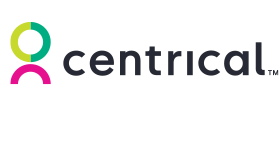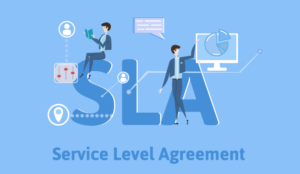SLAs, or Service Level Agreements, are an important part of operating a call centre. With an SLA, there is a clear understanding of the required standards and metrics.
In this article, we’ll take a deeper look at the SLA call centre definition, key components, common SLA call centre metrics, how to improve SLAs in your call centre, and a few key takeaways.
SLA Explained and Key Components of SLA
SLA, or Service Level Agreement, is a formal agreement around the service quality level and performance standards that a customer can expect from a call centre.
SLAs in call centres help guide management decisions and ensure that certain benchmarks are met and that customers receive a consistent and satisfactory experience.
There are a variety of key components of an SLA in a call centre – below are a few of the most common:
Service Level Metrics
This specifies performance metrics, which can include response time, resolution time, abandonment rate, and customer satisfaction scores. These metrics help quantify the quality of service provided.
Service Level Targets
These are the goals or benchmarks that the call centre aims to achieve for each specific metric.
For example, the SLA call centre formula may define a target of answering 80% of calls within 20 seconds or resolving 90% of customer issues within one hour.
Escalation Procedures
SLAs often include procedures for when service levels are not met. One example: if the call centre consistently fails to meet response time targets, the SLA may outline a process for escalating the issue to higher levels of management or even terminating the contract.
Legal and Compliance Considerations
Depending on the industry and regulatory requirements, there may be legal and compliance considerations that need to be addressed within the SLA, such as data privacy and security.
SLA Metrics and Measurements
Below are some of the most common SLA call centre metrics and their formulas. It’s important to regularly track and analyze these metrics to drive continuous improvement in call centre operations.
Service Level (SL)
This is the percentage of calls answered within a specific time frame. It is typically stated as X% of calls answered in Y seconds.
This is measured by calculating the number of calls answered within the defined timeframe divided by the total number of calls and multiplying by 100.
First Call Resolution (FCR)
The percentage of calls that are resolved without the need for the caller to make a follow-up call.
This is measured by calculating the number of calls resolved on the first contact, then dividing by the total number of calls, and multiplying by 100.
Average Handling Time (AHT)
The average time it takes an agent to handle a call from start to finish, including hold time and after-call work.
This is determined by taking the sum of the total time spent on all calls and dividing it by the total number of calls.
Customer Satisfaction (CSAT)
A measure of customer satisfaction based on post-call surveys or feedback. This is typically measured by asking customers to rate their satisfaction on a scale (1-5, 1-7, etc.) with the average score calculated.
Net Promoter Score (NPS)
A metric that measures customer loyalty by asking how likely customers are to recommend your service to others.
Like CSAT, this metric involves customer feedback on a scale (usually from 0 to 10) where respondents are categorized as Promoters (9-10), Passives (7-8), and Detractors (0-6). NPS is the percentage of Promoters minus the percentage of Detractors.
Types of SLAs
There are different types of SLAs in the call centre, including:
Response Time SLAs focus on the time it takes for a call centre agent to answer an incoming call or respond to a customer’s inquiry. For example, the SLA may specify that 80% of calls must be answered within 20 seconds.
Resolution Time SLAs set targets for how quickly call centre agents should resolve customer issues or inquiries. This could include metrics like resolving 90% of cases within two hours or providing a first-call resolution rate of 75%.
Service Availability SLAs are often used for call centres with 24/7 support and define the minimum percentage of time that the call centre must be operational and ready to assist customers. For example, it might require the call centre to be available 99.9% of the time.
Customer Satisfaction (CSAT) SLAs set targets for achieving a certain level of customer satisfaction, often measured through post-interaction surveys or feedback forms. For instance, the SLA might aim for a CSAT score of 85% or higher.
Service Quality SLAs focus on the overall quality of service provided by call centre agents, such as etiquette, knowledge, and adherence to scripts or guidelines.
First-Call Resolution (FCR) SLAs measure the percentage of customer inquiries that are resolved on the first call without the need for follow-ups or escalations. The SLA may set a target FCR rate, such as 80%.
Benefits of SLAs in a Call Centre
An SLA in a call centre is tremendously beneficial. Overall, a call centre SLA gives leaders a big picture of the customer experience and enables them to identify and address gaps.
A call centre SLA also ensures enhanced service quality, clear expectations for both clients and staff, better resource management, cost control, targeted performance monitoring, and ultimately, improved customer experience and retention rates.
How to Improve SLAs in Your Call Centre
Improving SLAs in a call centre is an ongoing task, but there are strategies to make this an attainable goal. We’ve shared a few top recommendations below:
Clearly Define SLAs
Make sure everyone in the call centre understands these goals.
Ensure That SLAs Are Realistic and Achievable
If the goals of SLAs in the call centre are too ambitious, this can lead to employee burnout and decreased customer satisfaction.
Invest in Technology
Implement software that can help track and manage SLAs, such as workforce management tools and reporting and analytics solutions.
Monitor Performance
Real-time monitoring and reporting help keep a close eye on call centre performance. Regularly review SLA call centre metrics to identify trends and areas for improvement.
Train and Coach Agents
Meeting SLA call centre goals starts with a well-trained frontline workforce. Explore tech platforms that leverage AI and provide targeted microlearning, augmented coaching, and fast training content creation.
Empower Agents
As part of training, empower agents with the authority and resources they need to resolve customer issues quickly and effectively, such as access to knowledge bases that enable them to meet SLAs.
Implement Quality Assurance Programs
Such programs help ensure that agents adhere to SLAs in the call centre while providing excellent customer service.
Recognize and Reward
Give kudos to teams and individuals who consistently meet, exceed, and improve on call centre SLAs. When addressing failures, focus on root causes and solutions rather than blame.
Gamify the Experience
Tying gamification to the employee experience, including learning and goals, helps motivate agents, keep them engaged in their work, and boost their performance.
Create a Culture of Learning
Document and share best practices among your call centre staff, and encourage employee contributions, where staff shares their own tips and tricks with colleagues.
Summary and Key Takeaways
We’ve just covered some basics around SLAs in the call centre, including SLA call centre metrics and formulas, the benefits of an SLA in a call centre, and some strategies to help call centres meet their SLAs. A few key takeaways:
SLAs in a call centre are an important part of conducting business. They help deliver a consistent customer experience that meets expectations, resulting in customer trust and retention.
SLA call centre metrics commonly include goals such as CSAT, NPS, FCR, AHT, and other KPIs that translate into a service level. Metrics should be clear to staff, realistic, and reachable.
Top strategies for reaching SLA call centre goals include training, guiding, and empowering agents, investing in the right technology, creating a culture of learning, and having a robust QA process in place.
This blog post has been re-published by kind permission of Centrical – View the Original Article
For more information about Centrical - visit the Centrical Website
Call Centre Helper is not responsible for the content of these guest blog posts. The opinions expressed in this article are those of the author, and do not necessarily reflect those of Call Centre Helper.
Author: Centrical
Published On: 4th Dec 2023 - Last modified: 9th Dec 2024
Read more about - Guest Blogs, Centrical






 Centrical provides a real-time performance management, microlearning, gamification, coaching, and voice of the employee platform for frontline teams. The solution inspires and personally guides employee success and growth by making every moment actionable.
Centrical provides a real-time performance management, microlearning, gamification, coaching, and voice of the employee platform for frontline teams. The solution inspires and personally guides employee success and growth by making every moment actionable. 






























